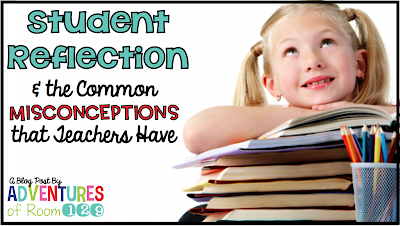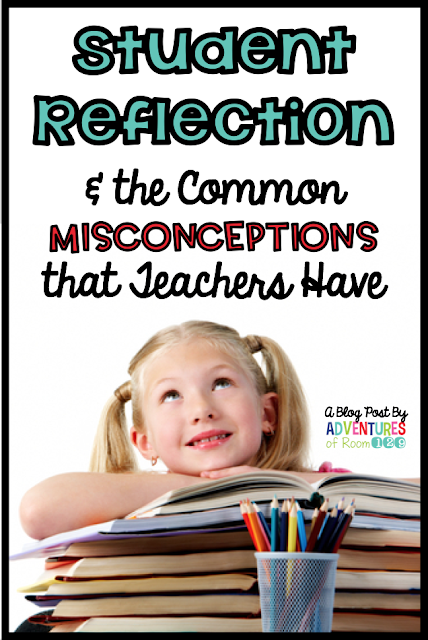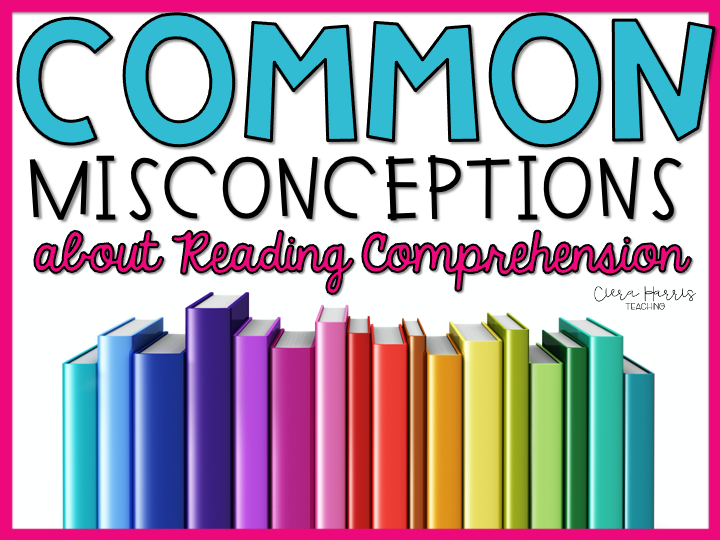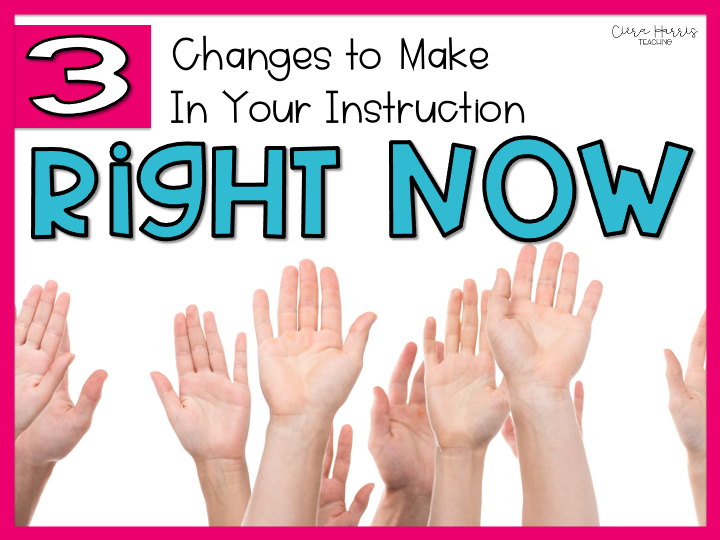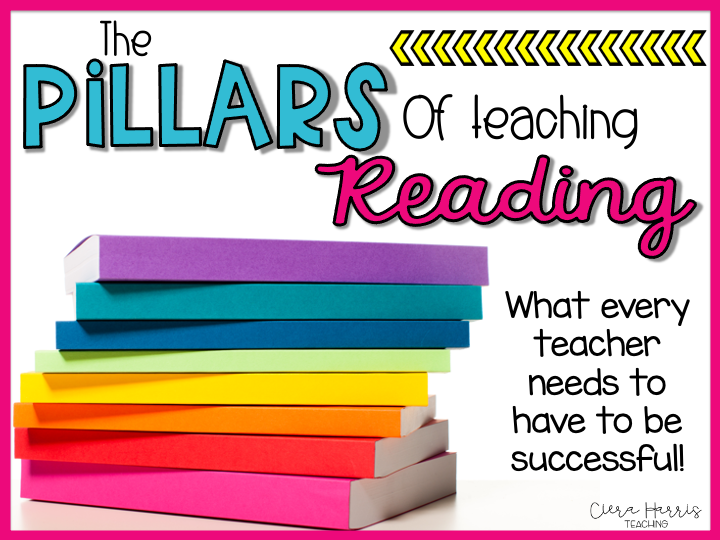Now days, teaching is so much more than delivering content. It’s about developing the whole learner – a student who is self sufficient, responsible, flexible, thinks outside of the box, and empathetic. It’s a lot on their plate as well as ours as their teacher! So on top of teaching our content areas, we also need to be helping round out the well groomed children in our classrooms. But how can students be a part of this? How can we get students to step up and take responsibility for their own learning and hold themselves accountable for their journey. Two words – Student Reflection. When we have our students consistently reflect upon their learning & their journey, we are allowing them to take control of their own education. They can make decisions for themselves based on their own data. They get to sit in the driver’s seat for once. But – with all aspects of teaching, there are many misconceptions to student reflection that I would like to set straight. By the end of this post, I hope that you truly can see and understand the potential and impact that student reflection can have on a student’s growth & achievement.
Misconception #1: Student Reflection is Natural
In my experience as a teacher and an instructional coach, I’ve found that many teachers see and want to harness the power behind having students reflect on their work, however they assume that
‘reflection’ is a natural part of the learning process and that students just know how and what to do. This is not true. Teachers are a reflective bunch, but that’s because we’ve been taught how to. Reflection is a learned skill. It is learned through observing others. When we ask our students to reflect on their learning without having taught or modeled, students don’t know where to start their thinking. They don’t understand what’s important to reflect on and not to reflect on. Where do they start? How? Why? Do you see the confusion that students will/might have if we just throw this ‘reflection’ at them? We need to teach our students how to reflect.
(See Photo!) A super simple way to model for your students is to complete the ‘reflection activity’ you’re having your students do, yourself! Let them see you do it and hear the process themselves!
Misconception #2: Students Don’t Need Reminders to Reflect on their Learning
Since we learned from the previous misconception that student reflection isn’t something that comes naturally to students, this misconception naturally makes sense. Students need to know when to reflect on their learning. They need reminders, modeling, support, explanation. And remember that reflecting doesn’t necessarily mean that it needs to be at the end of a lesson or activity. Remind
students to reflect before, during, and after a lesson to get the most out of their level of understanding and growth. If you want the most out of their learning and growth – then make sure you’re reminding students to reflect!
——–> An easy way to do this is to make reflection a part of your routine! Making or creating a reflection journal where students can simply write out their thoughts on a lesson/activity or the day is super helpful (and you can use them when conferring with students!). Giving them sentence starters in their journals is helpful to get them started thinking, especially if they are in younger grades!
Misconception #3: Students Understand What It Means to Reflect
First off, when we reflect – that encompasses a wide variety thinking. Students don’t know what questions to ask themselves to reflect on. Students need examples of reflection to know what to do and how to think through their own experiences. Reflection is about the process of thinking not about the product that they are producing. It’s about the ‘How’. When students are reminded to reflect, have been given ample models of thinking to use to mirror, and understand what it means to truly reflect –
then you’re going to get the deeper and more confident reflection from your students! So as a teacher – I’m modeling reflecting, giving concrete and specific examples and ways for my students to reflect, and making it a specific part of my lesson to get the most out of my students.
<————— Giving students a concrete way to reflect helps them understand the process even better! One of my favorite and easy ways to do this is to create a stop light and use clothes pins with students’ names on them. Before, during, or after a lesson – have the students reflect on their level of understanding on the concept and place their clothes pin next to the color that matches their level. This allows you to locate quickly students who need more help or pair students up for an activity!
Misconception #4: Students Only Need to Reflect on Graded Work
This is something I’ve noticed even from teachers who have upped their ‘reflection game’! Think of this – by the time it’s graded.. it’s too late! (not completely, but you get what I’m saying). We want to make sure the students get the chance to reflect during the process of learning to get the ample chance to grow as much as they can during the lesson! So when we have them reflect at the beginning we
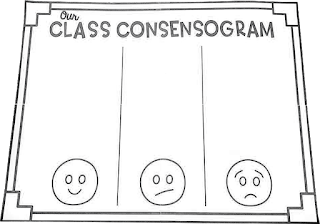 |
| Consensograms are perfect for reflecting at any point in a lesson and it gives the teacher amazing data to use to identify students for small groups! |
are allowing students to think about their prior knowledge, think about how they’ve done on a previous assignment that’s been connected to so they know where and what in today’s lesson they need to focus and work on. When we have them pause and reflect in the middle of a lesson, we are giving them the chance to think about what they need from me, the teacher, that might impact their outcome by the end of the lesson, what questions they have that they don’t understand, and how and what they need to change in themselves to get the most out of the lesson. When we reflect at the end of a lesson, we are allowing students to make a game plan or an action plan for ‘next time’ or identifying areas that are great for small groups and interventions! This also is perfect for encouraging a growth mindset in our students as well. (Want to get started with Growth Mindset? Check out this great post on 5 Ways to Get Started with Growth Mindset). So it doesn’t just have to be on graded work!
Misconception #5: Students Only Need to Reflect on the Mistakes That They Make
When it comes to success (for adults and children), it’s important to know what impacted your success. So when it comes to reflection, we need to make sure we’re teaching students to not only reflect on the mistakes that they are making to change them and grow – but also to reflect on what went right and how that made them successful. Doing this allows them to repeat this and hopefully
apply it to another area in their day to have more success. Students need to see both sides – what positively impacts their learning and what isn’t allowing them to learn. This allows them, too, to reflect on areas in their life that just aren’t about academics. This can apply to behavior, social, and many other areas as well. Reflection is truly a life long skill and when we put all of this together, we are teaching them that!
(See Photo!) Sometimes it’s just about asking the right question. So to make sure students are reflecting on both sides of the spectrum – just make sure you’re asking a variety of questions!
So if you didn’t think it before, hopefully you do now. Student reflection is an important and necessary part to a student’s growth and achievement. It takes much of the responsibility that is on the teacher’s shoulders and places it also on the student’s shoulders. And why shouldn’t it be on theirs as well? It’s our responsibility to teach our students to become well rounded people and what better way to do that, than reflect on their own journeys?
If you want to get started with student reflection and/or need some new and concrete ideas to add to your toolbox, then definitely check out my Student Reflection Mega Pack! It’s loaded with ready to use ideas and printables for teachers and students!

